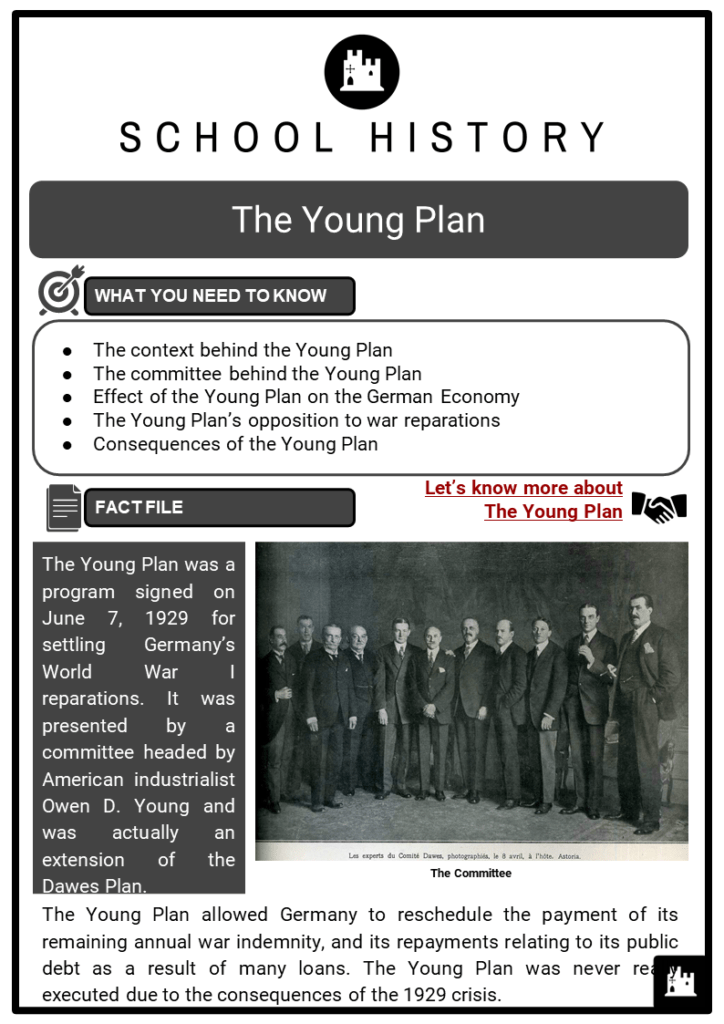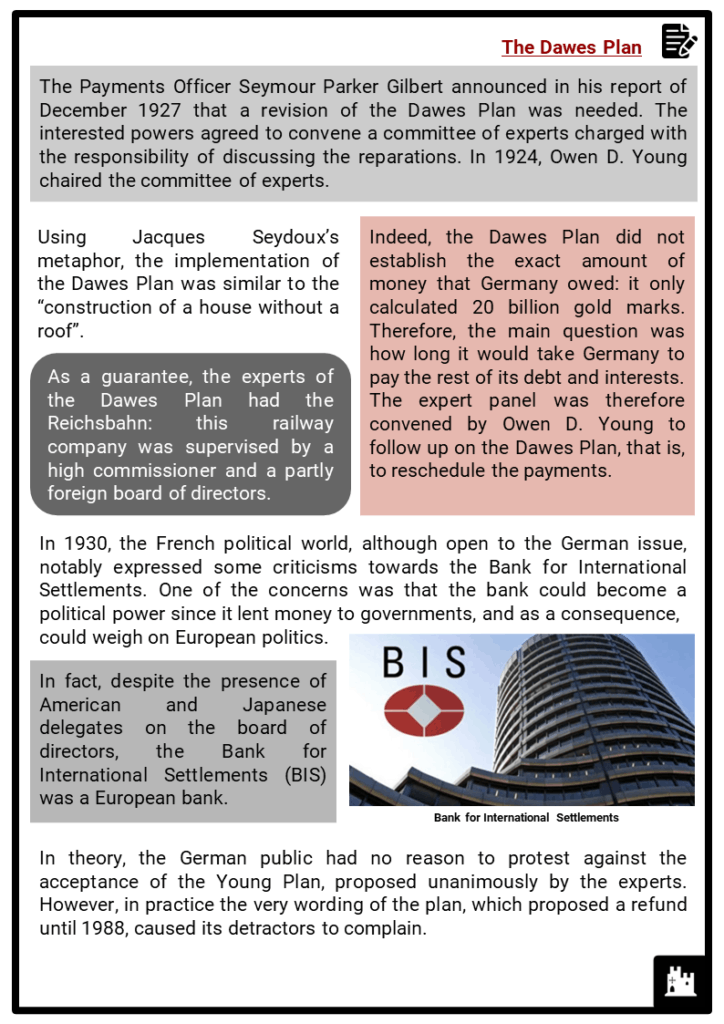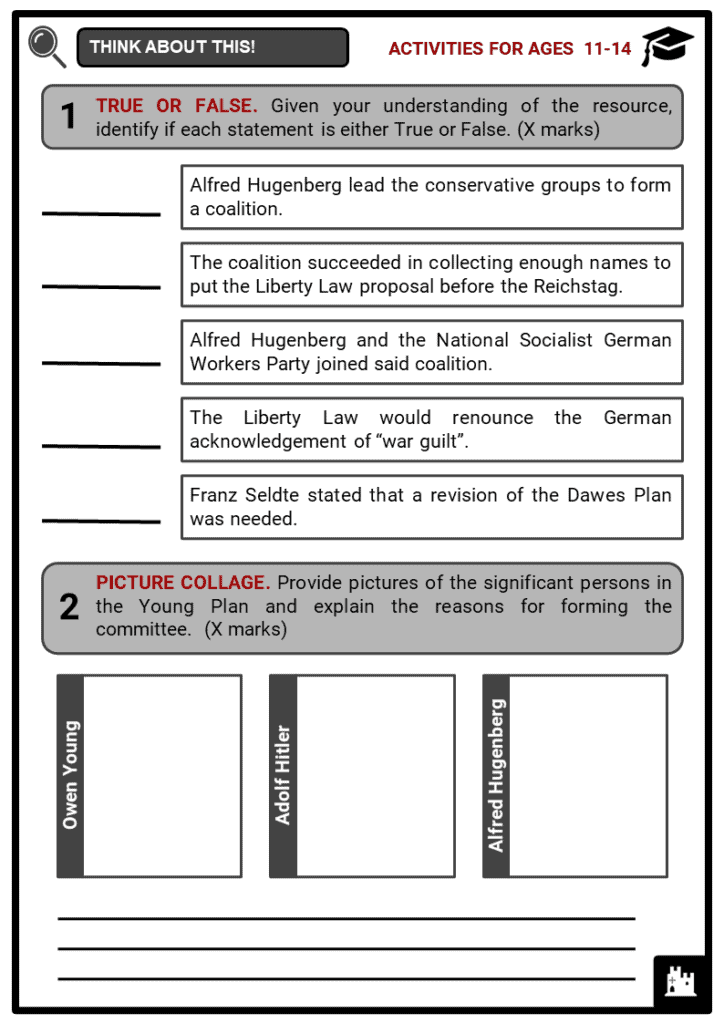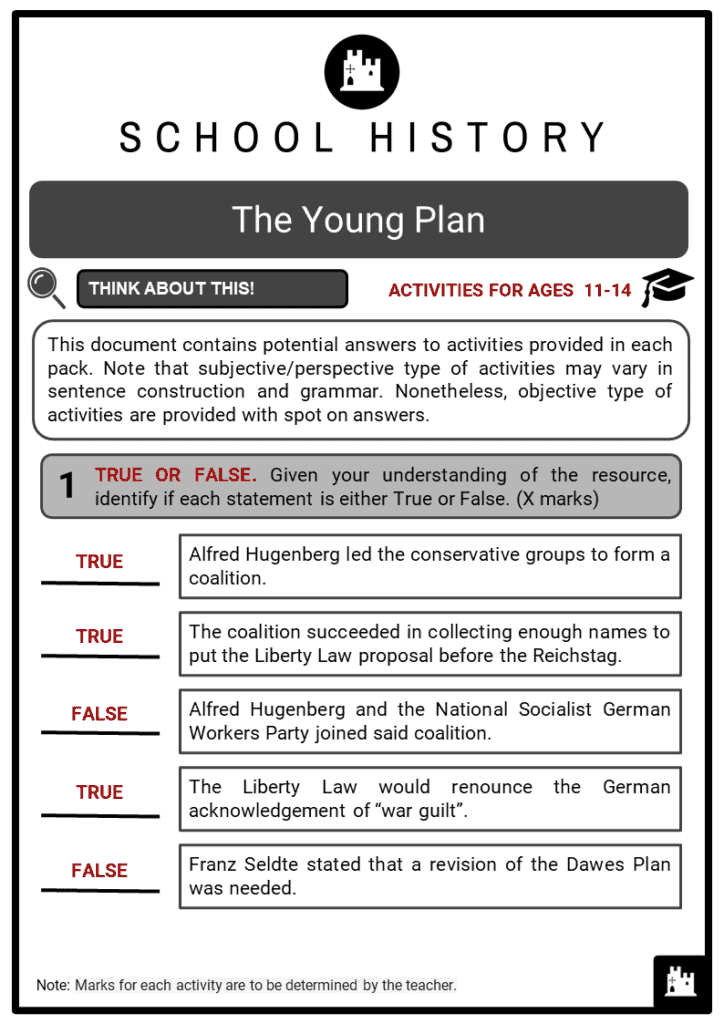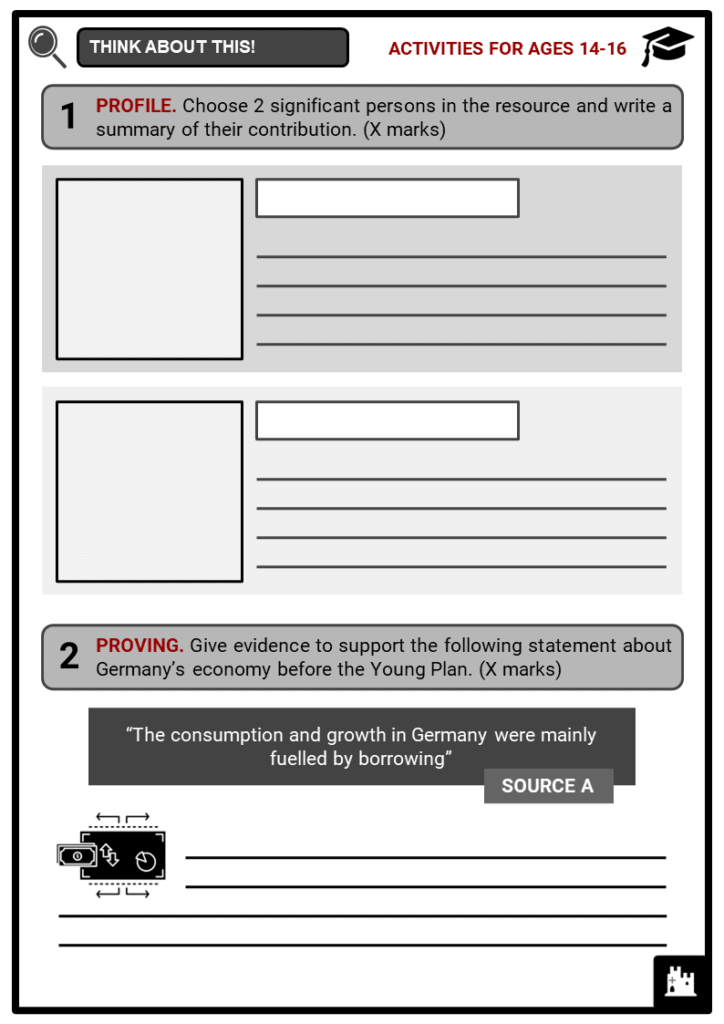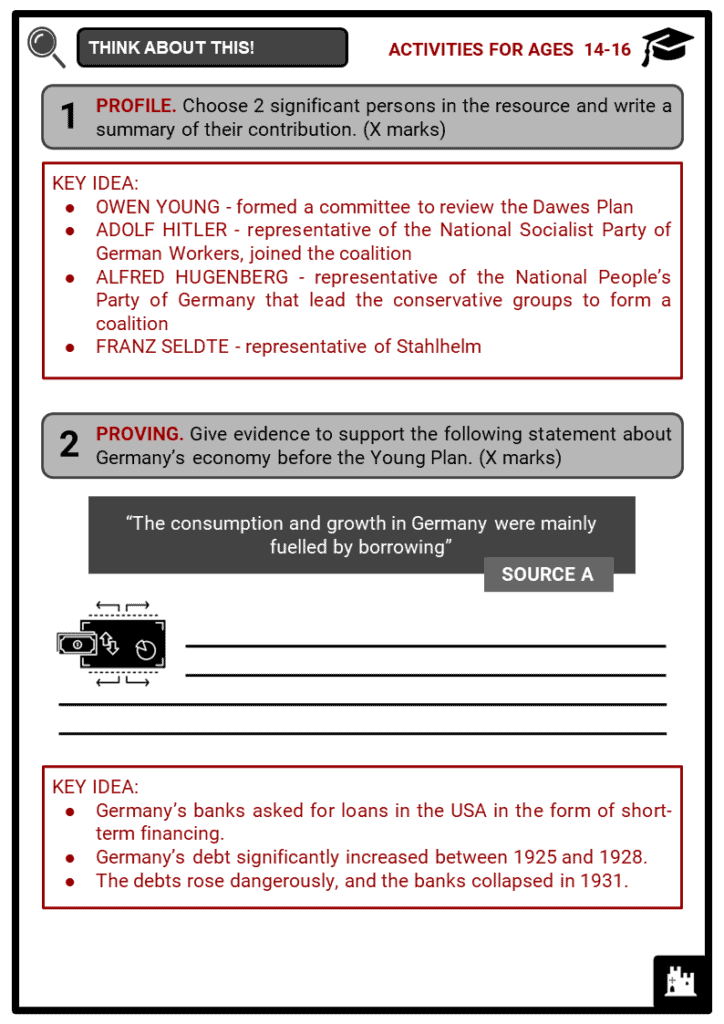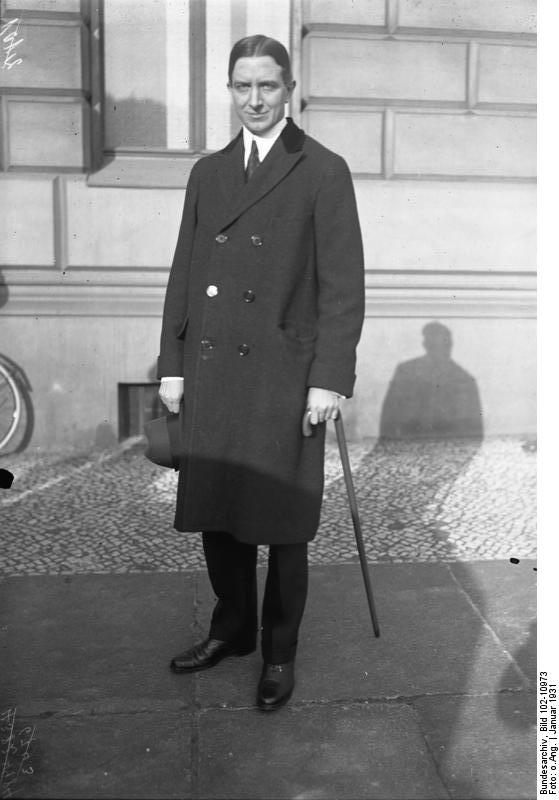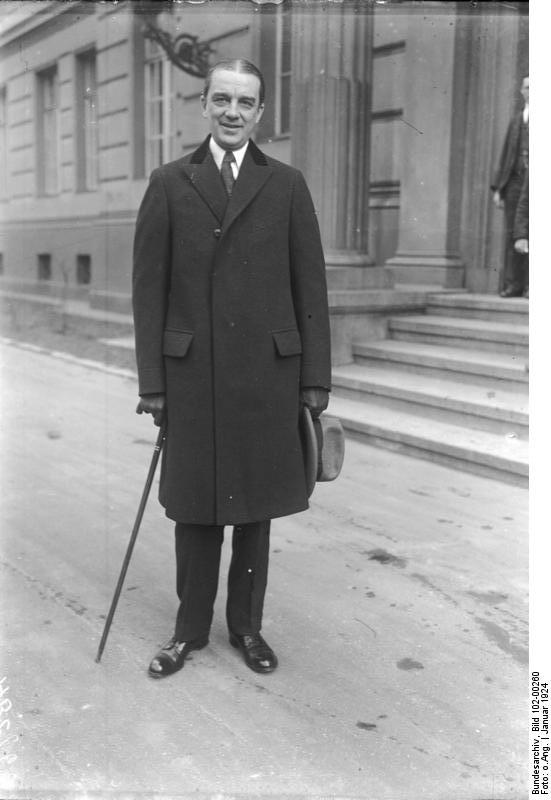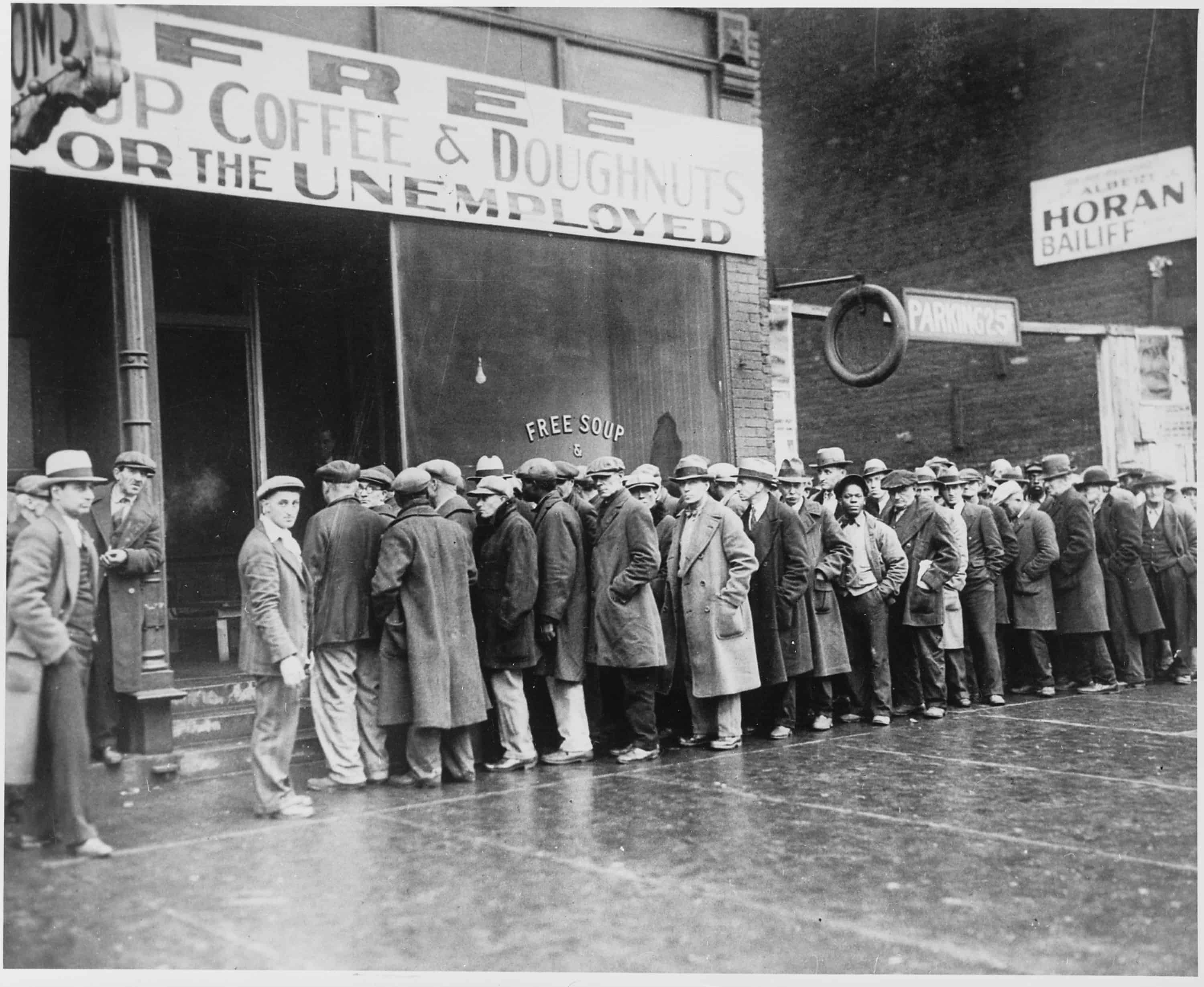Download The Young Plan Worksheets
Do you want to save dozens of hours in time? Get your evenings and weekends back? Be able to teach The Young Plan to your students?
Our worksheet bundle includes a fact file and printable worksheets and student activities. Perfect for both the classroom and homeschooling!
Table of Contents
Add a header to begin generating the table of contents
Summary
- The context behind the Young Plan
- The committee behind the Young Plan
- Effect of the Young Plan on the German Economy
- The Young Plan’s opposition to war reparations
- Consequences of the Young Plan
Key Facts And Information
Let’s know more about The Young Plan
- The Young Plan was a program signed on June 7, 1929 for settling Germany’s World War I reparations. It was presented by a committee headed by American industrialist Owen D. Young and was actually an extension of the Dawes Plan.
- The Young Plan allowed Germany to reschedule the payment of its remaining annual war indemnity, and its repayments relating to its public debt as a result of many loans. The Young Plan was never really executed due to the consequences of the 1929 crisis.
The Dawes Plan
- The Payments Officer Seymour Parker Gilbert announced in his report of December 1927 that a revision of the Dawes Plan was needed. The interested powers agreed to convene a committee of experts charged with the responsibility of discussing the reparations. In 1924, Owen D. Young chaired the committee of experts.
- Using Jacques Seydoux’s metaphor, the implementation of the Dawes Plan was similar to the “construction of a house without a roof”.
- As a guarantee, the experts of the Dawes Plan had the Reichsbahn: this railway company was supervised by a high commissioner and a partly foreign board of directors.
- Indeed, the Dawes Plan did not establish the exact amount of money that Germany owed: it only calculated 20 billion gold marks. Therefore, the main question was how long it would take Germany to pay the rest of its debt and interests. The expert panel was therefore convened by Owen D. Young to follow up on the Dawes Plan, that is, to reschedule the payments.
- In 1930, the French political world, although open to the German issue, notably expressed some criticisms towards the Bank for International Settlements. One of the concerns was that the bank could become a political power since it lent money to governments, and as a consequence,
- could weigh on European politics.
- In fact, despite the presence of American and Japanese delegates on the board of directors, the Bank for International Settlements (BIS) was a European bank.
- In theory, the German public had no reason to protest against the acceptance of the Young Plan, proposed unanimously by the experts. However, in practice the very wording of the plan, which proposed a refund until 1988, caused its detractors to complain.
- That is why on June 15 the National People’s Party of Germany (DNVP) issued a manifesto against the Young Plan, and the population proposed to launch a referendum against it. A “Reich Committee on the Referendum against the Young Plan” was created on July 9, 1929. It included representatives of Stahlhelm (Franz Seldte), DNVP (Alfred Hugenberg) and the National Socialist Party of German Workers (NSDAP) (Adolf Hitler).
- During the re- examination of the Young Plan, the draft of the “law against the enslavement of the German people” was discussed in the Reichstag on November 29-30, 1929. However, the law was rejected by the Reichstag and by the referendum.
The “Liberty Law”
- Alfred Hugenberg, the head of the German National People’s Party, led the conservative groups to form a coalition. Adolf Hitler and the National Socialist German Workers Party joined the said coalition.
- The Young Plan was opposed by some parts of the political spectrum in Germany despite how it effectively reduced the obligations of the country. The conservative groups were the most outspoken in opposition to reparations.
- The goal of the coalition was the enactment of the Freiheitsgesetz or the “Liberty Law”. This was suggested to renounce the reparations, and the cooperation of any German official would be a criminal offence. The Liberty Law would also renounce the occupation of German territory involved in the Treaty of Versailles, and the German acknowledgement of “war guilt”.
- Under the terms of the German constitution, the Reichstag had to put a proposed law to vote if 10% of the eligible voters within the country signed a petition in favour of the matter.
- The said proposal would be automatically be put to a national referendum if the Reichstag voted against the law.
- However, if 50% of the people who voted were in favour of it, it would become a law.
- The Liberty Law proposal was officially accepted on October 16, 1929. The government staged demonstrations against the Liberty law while the National Socialists and other groups held large public rallies to collect signatures.
- The coalition succeeded in collecting enough names to put the Liberty Law proposal before the Reichstag. The Liberty Law referendum was held in December 22 of the same year, resulting in 14.9% legitimate votes and 94.5% of these were in favour of the proposed Law, about 13.8%.
The Working Committee
- On February 11, 1929, a financial group chaired by Owen D. Young formed a committee to review the Dawes Plan. Meanwhile, the German press was promoting a strong campaign in order to prove that the committee should study Germany’s problem under a new perspective and that a very large reduction should be made in order for the country to repay the debt.
- During the committee’s meeting, the possibility of creating a Bank of International Settlements (BIS) was discussed. Such a bank had to receive German payments, ensuring the transfer and distribution among creditors. Essentially, such a system consisted of “control without control” (Pépy 1929). The bank would cooperate with all the governments concerned. Its application began in January 1930.
The Aftermath
- The country recovered its economy in 1924 and 1925 thanks to the economic policy of Hjalmar Schacht, supported by the American financial aid. As Germany was growing economically (5% to 6% on average), banks needed funds to invest and lend.
- They often found their solution abroad, particularly in the United States in the form of short-term financing.
- The four major German banks — Danatbank, Deutsche Bank (then called DeDiBank), Commerzbank and Dresdner Bank — competed fiercely for loans from the USA. Loans were granted to companies and individuals without precautions.
- Thus, between 1925 and 1928, Germany’s debt increased from 19.7% to 43.7%.
- The level of risk rose dangerously and in July 1931 Germany’s banks collapsed. Since 1924, consumption and growth in Germany had been mainly fuelled by borrowing. This did not prevent the country from paying its sovereign debt.
- During the negotiations and the adoption of the Young Plan, the Fall of Wall Street occurred on October 24, 1929, which brought serious consequences.
- Firstly, this event caused the United States banks to withdraw their funds from Europe and then to cancel the credits that the Young Plan had made (this plan, like the Dawes Plan, was based on US bank loans to Germany).
- The reduction in the level of imports and exports caused world trade to fall by two-thirds by 1933, affecting all the countries of the world in one way or another.
- Due to the Great Depression, the United States approved the Hawley-Smoot Act on June 17, 1930, increasing tariffs on imported products and promoting a protectionist policy that made international trade more difficult. These choices seriously harmed European countries that traded with the United States.
- Germany was an industrialised country. However, it was heavily dependent on world trade. Unemployment reached 33.7% in 1931 and 40% in 1932.
- Under these circumstances, the American president Herbert Hoover publicly proposed a one-year moratorium on payments for the Young Plan, winning the support of fifteen nations in July 1931.
- However, the moratorium did not help to stop the serious economic problems that had already spread throughout Europe, especially when Germany itself faced a severe banking crisis.
- In 1932, at the Conference in Lausanne (Switzerland), one last effort was made, and the representatives of Great Britain, France, Italy, Belgium, and Japan reached an agreement.
- At this time, it was already evident that the economic depression of the 1930s had made it impossible for Germany to repay its debts. The countries present in Lausanne agreed the following points:
- Not to demand immediate payments from Germany.
- Reduce borrowing by 90% and require Germany to start issuing bonds to pay the debt. Such a measure would almost cancel the existing debt, reducing Germany’s outstanding obligations from 32.3 billion dollars to 713 million dollars.
- The delegates were also informed that these provisions would not be effective unless the US government agreed to cancel the war debts owed by the Allied governments.
- When in 1933 the Nazi Party took power in Germany, the debt was officially rejected by Hitler’s regime, who completely refused to continue the payments. This caused the bonds issued by the Weimar Republic to become suddenly worthless, to the detriment of the American banks and investors that had bought them.
- At the end of the Second World War, the winning countries agreed in a 1953 conference that Germany would pay all remaining debts incurred since 1919 only after the unification of the country. However, in 1980 the Federal Republic of Germany paid the amount of the principal debt, and in 1995, after its reunification, the German government announced that it would begin to pay interest.
Image sources:
[2.] https://upload.wikimedia.org/wikipedia/commons/2/2c/Bundesarchiv_Bild_102-00260%2C_Owen_D._Young.jpg
[3.] https://upload.wikimedia.org/wikipedia/commons/1/10/Comit%C3%A9_Dawes.jpg

